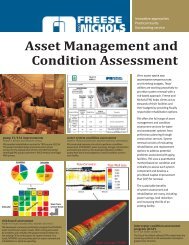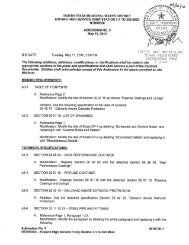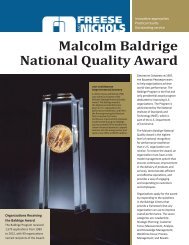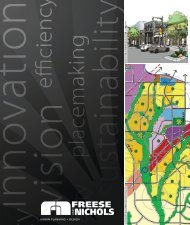final bid specs 09328.pdf - Freese and Nichols, Inc.
final bid specs 09328.pdf - Freese and Nichols, Inc.
final bid specs 09328.pdf - Freese and Nichols, Inc.
You also want an ePaper? Increase the reach of your titles
YUMPU automatically turns print PDFs into web optimized ePapers that Google loves.
a. Measure outlet static pressure as far downstream from the fan as practicable <strong>and</strong> upstream<br />
from restrictions in ducts such as elbows <strong>and</strong> transitions.<br />
b. Measure static pressure directly at the fan outlet or through the flexible connection.<br />
c. Measure inlet static pressure of single-inlet fans in the inlet duct as near the fan as<br />
possible, upstream from flexible connection <strong>and</strong> downstream from duct restrictions.<br />
d. Measure inlet static pressure of double-inlet fans through the wall of the plenum that<br />
houses the fan.<br />
2. Measure static pressure across each component that makes up an air-h<strong>and</strong>ling unit, rooftop<br />
unit, <strong>and</strong> other air-h<strong>and</strong>ling <strong>and</strong> -treating equipment.<br />
a. Simulate dirty filter operation <strong>and</strong> record the point at which maintenance personnel<br />
must change filters.<br />
3. Measure static pressures entering <strong>and</strong> leaving other devices such as sound traps, heat<br />
recovery equipment, <strong>and</strong> air washers, under <strong>final</strong> balanced conditions.<br />
4. Compare design data with installed conditions to determine variations in design static<br />
pressures versus actual static pressures. Compare actual system effect factors with calculated<br />
system effect factors to identify where variations occur. Recommend corrective<br />
action to align design <strong>and</strong> actual conditions.<br />
5. Obtain approval from Owners Representative for adjustment of fan speed higher or lower<br />
than indicated speed. Make required adjustments to pulley sizes, motor sizes, <strong>and</strong> electrical<br />
connections to accommodate fan-speed changes at no additional cost.<br />
6. Do not make fan-speed adjustments that result in motor overload. Consult equipment<br />
manufacturers about fan-speed safety factors. Modulate dampers <strong>and</strong> measure fanmotor<br />
amperage to ensure that no overload will occur. Measure amperage in full cooling,<br />
full heating, economizer, <strong>and</strong> any other operating modes to determine the maximum required<br />
brake horsepower.<br />
B. Adjust volume dampers for main duct, submain ducts, <strong>and</strong> major branch ducts to indicated<br />
airflows within specified tolerances.<br />
1. Measure static pressure at a point downstream from the balancing damper <strong>and</strong> adjust volume<br />
dampers until the proper static pressure is achieved.<br />
a. Where sufficient space in submain <strong>and</strong> branch ducts is unavailable for Pitot-tube traverse<br />
measurements, measure airflow at terminal outlets <strong>and</strong> inlets <strong>and</strong> calculate the<br />
total airflow for that zone.<br />
2. Remeasure each submain <strong>and</strong> branch duct after all have been adjusted. Continue to adjust<br />
submain <strong>and</strong> branch ducts to indicated airflows within specified tolerances.<br />
C. Measure terminal outlets <strong>and</strong> inlets without making adjustments.<br />
1. Measure terminal outlets using a direct-reading hood or outlet manufacturer's written instructions<br />
<strong>and</strong> calculating factors.<br />
D. Adjust terminal outlets <strong>and</strong> inlets for each space to indicated airflows within specified tolerances<br />
of indicated values. Make adjustments using volume dampers rather than extractors<br />
<strong>and</strong> the dampers at air terminals.<br />
1. Adjust each outlet in same room or space to within specified tolerances of indicated<br />
quantities without generating noise levels above the limitations prescribed by the Contract<br />
Documents.<br />
2. Adjust patterns of adjustable outlets for proper distribution without drafts.<br />
3.06 PROCEDURES FOR MOTORS<br />
A. Motors, 1/2 HP <strong>and</strong> Larger: Test at <strong>final</strong> balanced conditions <strong>and</strong> record the following data:<br />
Testing, Adjusting, <strong>and</strong> Balancing 23 05 93 - 5<br />
DPR09328












